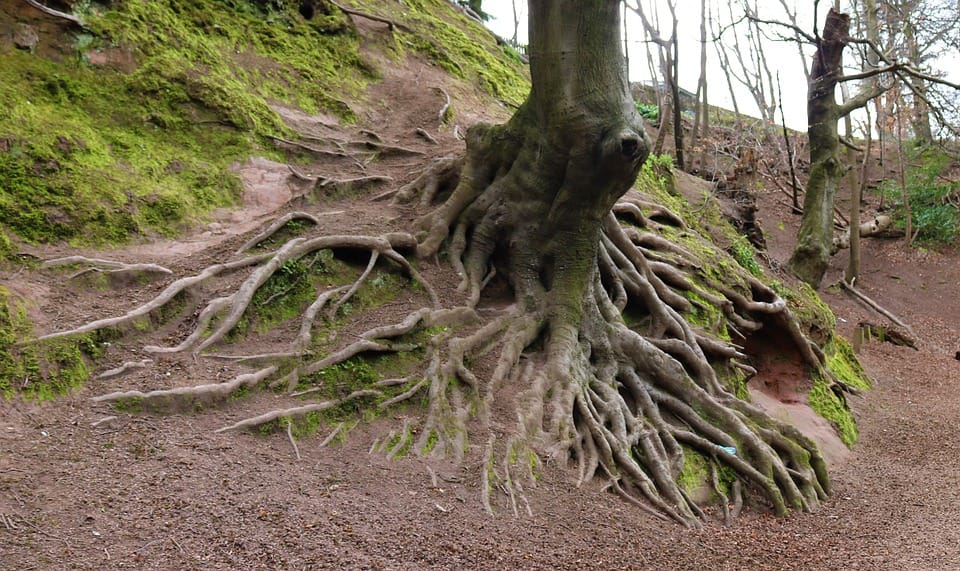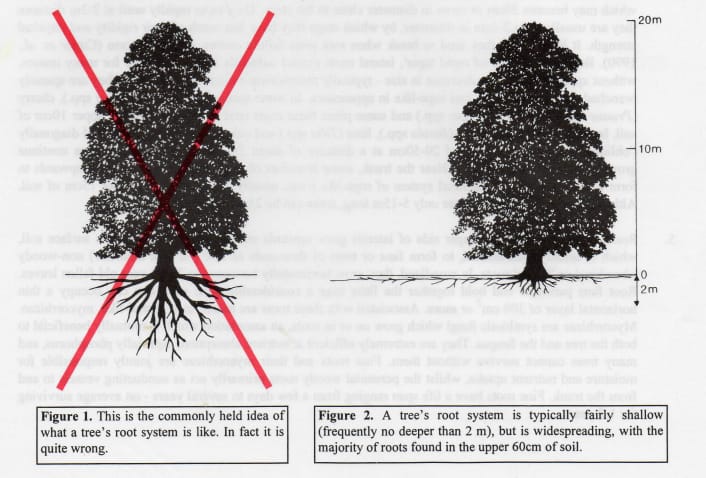
We’re going to start by defining the different types of roots and what purpose they serve to the tree. There are taproots, structural (or lateral) roots, sinker roots, and fine roots.
Taproot
In our current water saving culture, we flock towards trees with a “deep taproot” in order to decrease irrigation frequency and quantity. While taproots can extend to astounding lengths in nature, they rarely do in the urban setting. Martin Dobson explains in Tree Root Systems:
“Development of the taproot then declines with the result that only a small proportion of trees have a sizeable taproot at maturity. In fact, it is hard to distinguish a taproot at all in many mature trees, as injury to the juvenile taproot tip often occurs, for example, by the browsing of soil fauna, root rot, failure to penetrate hard or compact soil layers, or for nursery stock, by undercutting/transplanting.”
https://www.trees.org.uk/Trees.org.uk/files/61/6181f2b7-e35d-4075-832f-5e230d16aa9e.pdf
Compaction is the major contributor to why we don’t see long taproots in urban settings.
But what about oaks you say? Don’t they have really deep taproots? Dobson continues:
“Species often thought of as ‘taprooted’, such as oak, pine, and fir, appear to have a stronger inherent tendency to retain a distinct taproot, than species such as poplar, willow, and spruce, but frequently the taproot does not persist even in these species. Intact taproots are usually largest just beneath the trunk and taper until they reach a depth of 0.5-1m, where they often divide into several smaller, but nevertheless downwardly growing roots.”
https://www.trees.org.uk/Trees.org.uk/files/61/6181f2b7-e35d-4075-832f-5e230d16aa9e.pdf

There are also something called “Sinker Roots” which are small vertical roots that grow down from lateral structural roots. These are typically about 2cm in diameter, grow downwards, and divide into non-woody roots. These help to anchor the tree in addition to the large structural roots that grow laterally.
Large Structural Roots
Large structural roots are usually the roots responsible for moving the precious hardscapes of many homeowners. These roots grow large and can protrude through the surface of the soil. They are responsible for anchoring the tree. There are between 4-11 of these lateral roots and they can grow as thick as 12″.
The size of these lateral roots taper off quickly as they grow away from the tree. Dobson writes:
“They taper rapidly until at 2-3m (6-9′) distance they are usually only 2-5cm (0.787″-2″) in diameter”
https://www.trees.org.uk/Trees.org.uk/files/61/6181f2b7-e35d-4075-832f-5e230d16aa9e.pdf
Knowing this can help us to keep these large roots from damaging hardscapes such as driveways or exterior walls by planting the trees further than 10′ from them. We can encourage larger structural roots to grow deeper in the soil by mulching the soil with 2-4″ of wood chips (or other organic materials) to help reverse compaction of the soil and provide a more fertile soil.
Fine “Feeder” Roots
Fine roots are primarily located within the top 12″ of the soil. This is where the soil is most aerated. These roots are responsible for the uptake of water and nutrients. When the soil surface is damaged or disturbed, the fine roots typically experience the most damage. These roots are also the primary beneficiary of mulch. Mulch allows the soil to hold moisture longer and increases the microorganisms in the soil surface which in turn aid the roots in disease prevention, water retention, nutrient uptake, and drought resistance.
